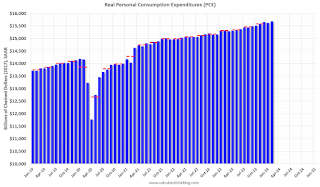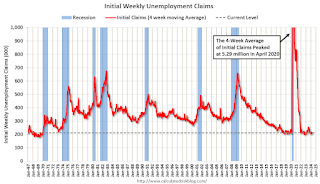by Calculated Risk on 3/29/2024 08:56:00 AM
Friday, March 29, 2024
PCE Measure of Shelter Slows to 5.8% YoY in February
Here is a graph of the year-over-year change in shelter from the CPI report and housing from the PCE report this morning, both through February 2024.

Since asking rents are mostly flat year-over-year, these measures will continue to slow over the next year.
The second graph shows PCE prices, Core PCE prices and Core ex-housing over the last 6 months (annualized):
 Key measures are slightly above the Fed's target on a 6-month basis.
Key measures are slightly above the Fed's target on a 6-month basis.PCE Price Index: 2.5%
Core PCE Prices: 2.9%
Core minus Housing: 2.3%
Personal Income increased 0.3% in February; Spending increased 0.8%
by Calculated Risk on 3/29/2024 08:30:00 AM
From the BEA: Personal Income and Outlays for February:
Personal income increased $66.5 billion (0.3 percent at a monthly rate) in February, according to estimates released today by the Bureau of Economic Analysis. Disposable personal income (DPI), personal income less personal current taxes, increased $50.3 billion (0.2 percent) and personal consumption expenditures (PCE) increased $145.5 billion (0.8 percent).The February PCE price index increased 2.5 percent year-over-year (YoY), up from 2.4 percent YoY in January, and down from the peak of 7.1 percent in June 2022.
The PCE price index increased 0.3 percent. Excluding food and energy, the PCE price index increased 0.3 percent. Real DPI decreased 0.1 percent in February and real PCE increased 0.4 percent; goods increased 0.1 percent and services increased 0.6 percent .
emphasis added
The following graph shows real Personal Consumption Expenditures (PCE) through January 2024 (2017 dollars). Note that the y-axis doesn't start at zero to better show the change.
 Click on graph for larger image.
Click on graph for larger image.The dashed red lines are the quarterly levels for real PCE.
Personal income was above expectations and PCE was at expectations.
Using the two-month method to estimate Q1 real PCE growth, real PCE was increasing at a 2.7% annual rate in Q1 2024. (Using the mid-month method, real PCE was increasing at 2.7%). This suggests solid PCE growth in Q1.
Thursday, March 28, 2024
Friday: Personal Income and Outlays, PCE Prices, Fed Chair Powell
by Calculated Risk on 3/28/2024 07:50:00 PM
All US markets will be closed in observance of Good Friday.

Friday:
• At 8:30 AM ET, Personal Income and Outlays for February. The consensus is for a 0.4% increase in personal income, and for a 0.5% increase in personal spending. And for the Core PCE price index to increase 0.3%. PCE prices are expected to be up 2.5% YoY, and core PCE prices up 2.8% YoY.
• At 11:30 AM, Discussion, Fed Chair Jerome Powell, Moderated Discussion with Kai Ryssdal, At the Federal Reserve Bank of San Francisco Macroeconomics and Monetary Policy Conference, San Francisco, Calif
Realtor.com Reports Active Inventory UP 25.5% YoY; New Listings up 14.9% YoY
by Calculated Risk on 3/28/2024 02:43:00 PM
What this means: On a weekly basis, Realtor.com reports the year-over-year change in active inventory and new listings. On a monthly basis, they report total inventory. For February, Realtor.com reported inventory was up 14.8% YoY, but still down almost 40% compared to February 2019.
Realtor.com has monthly and weekly data on the existing home market. Here is their weekly report: Weekly Housing Trends View—Data Week Ending March 23, 2024
• Active inventory increased, with for-sale homes 25.5% above year ago levels.
For an 20th straight week, active listings registered above prior year level, which means that today’s home shoppers are able to consider more options for existing homes for sale. However, the number of homes on the market is still down nearly 40% compared to what was typical in 2017 to 2019 and the gain in inventory, particularly in the more affordable under $350,000 price category, was primarily focused in the South last month. Nonetheless, in the first few weeks of March, inventory growth has also accelerated in the Midwest and West, while inventory in the Northeast remains similar to the previous year.
• New listings–a measure of sellers putting homes up for sale–were up this week, by 14.9% from one year ago.
For the 22nd consecutive week, newly listed homes have surpassed levels from a year ago. While the annual growth rate was slower than the 17.8% recorded a week earlier, it remains among the fastest increase rates in new listings since June 2021. This indicates a surge in fresh options for buyers as we approach the spring homebuying season. However, it’s worth noting that the inventory base for this growth remains relatively small.
 Here is a graph of the year-over-year change in inventory according to realtor.com.
Here is a graph of the year-over-year change in inventory according to realtor.com. Inventory was up year-over-year for the 20th consecutive week following 20 consecutive weeks with a YoY decrease in inventory.
Final Look at Local Housing Markets in February
by Calculated Risk on 3/28/2024 11:35:00 AM
Today, in the Calculated Risk Real Estate Newsletter: Final Look at Local Housing Markets in February
A brief excerpt:
Note: Most analysts were surprised by the increase in sales in February. Not housing economist Tom Lawler, or any readers of this newsletter. The local data clearly showed that sales - as reported by the NAR - would be up solidly in February. This is one of the reasons I track local markets. It is also useful to track inventory, both new and active.There is much more in the article.
After the National Association of Realtors® (NAR) releases the monthly existing home sales report, I pick up additional local market data that is reported after the NAR. This is the final look at local markets in February.
I’ve added a comparison of active listings, new listings, and closings to the same month in 2019 (for markets with available data). This gives us a sense of the current low level of sales and inventory, and also shows some significant regional differences.
The big stories for February were that existing home sales increased to 4.38 million on a seasonally adjusted annual rate basis (SAAR), and new listings were up YoY for the 5th consecutive month!
...
And here is a table for new listings in February (some areas don’t report new listings). For these areas, new listings were up 21.8% year-over-year.
Last month, new listings in these markets were up 8.6% year-over-year.
New listings are now up solidly year-over-year, but still at historically low levels. New listings in most of these areas are down compared to January 2019 activity.
...
More local data coming in April for activity in March!
NAR: Pending Home Sales Increase 1.6% in February; Down 7.0% Year-over-year
by Calculated Risk on 3/28/2024 10:00:00 AM
From the NAR: Pending Home Sales Rose 1.6% in February
Pending home sales in January grew 1.6%, according to the National Association of REALTORS®. The Midwest and South posted monthly gains in transactions while the Northeast and West recorded losses. All four U.S. regions registered year-over-year decreases.This was slightly above expectations. Note: Contract signings usually lead sales by about 45 to 60 days, so this would usually be for closed sales in March and April.
The Pending Home Sales Index (PHSI)* – a forward-looking indicator of home sales based on contract signings – increased to 75.6 in February. Year over year, pending transactions were down 7.0%. An index of 100 is equal to the level of contract activity in 2001.
...
The Northeast PHSI decreased 0.3% from last month to 63.4, a decline of 9.0% from February 2023. The Midwest index soared 10.6% to 81.6 in February, down 2.5% from one year ago.
The South PHSI rose 1.1% to 89.5 in February, falling 8.5% from the prior year. The West index fell 6.5% in February to 57.1, down 7.9% from February 2023.
emphasis added
Weekly Initial Unemployment Claims Decrease to 210,000
by Calculated Risk on 3/28/2024 08:35:00 AM
The DOL reported:
In the week ending March 23, the advance figure for seasonally adjusted initial claims was 210,000, a decrease of 2,000 from the previous week's revised level. The previous week's level was revised up by 2,000 from 210,000 to 212,000. The 4-week moving average was 211,000, a decrease of 750 from the previous week's revised average. The previous week's average was revised up by 500 from 211,250 to 211,750.The following graph shows the 4-week moving average of weekly claims since 1971.
emphasis added
 Click on graph for larger image.
Click on graph for larger image.The dashed line on the graph is the current 4-week average. The four-week average of weekly unemployment claims increased to 211,000.
The previous week was revised up.
Weekly claims were close to the consensus forecast.
Q4 GDP Growth Revised Up to 3.4% Annual Rate
by Calculated Risk on 3/28/2024 08:30:00 AM
From the BEA: Gross Domestic Product, Fourth Quarter and Year 2023 (Third Estimate), GDP by Industry, and Corporate Profits
Real gross domestic product (GDP) increased at an annual rate of 3.4 percent in the fourth quarter of 2023, according to the "third" estimate released by the Bureau of Economic Analysis. In the third quarter, real GDP increased 4.9 percent.
The GDP estimate released today is based on more complete source data than were available for the "second" estimate issued last month. In the second estimate, the increase in real GDP was 3.2 percent. The update primarily reflected upward revisions to consumer spending and nonresidential fixed investment that were partly offset by a downward revision to private inventory investment.
emphasis added
Wednesday, March 27, 2024
Thursday: GDP, Unemployment Claims, Pending Home Sales
by Calculated Risk on 3/27/2024 07:41:00 PM

Thursday:
• At 8:30 AM ET, Gross Domestic Product, 4th Quarter and Year 2023 (Third Estimate), GDP by Industry, and Corporate Profits. The consensus is that real GDP increased 3.2% annualized in Q4, unchanged from the second estimate.
• Also at 8:30 AM, The initial weekly unemployment claims report will be released. The consensus is for 208 thousand initial claims, down from 210 thousand last week.
• At 9:45 AM, Chicago Purchasing Managers Index for March. The consensus is for a reading of 43.0, down from 44.0 in February.
• At 10:00 AM, Pending Home Sales Index for February. The consensus is for a 2.0% increase in the index.
• Also at 10:00 AM, University of Michigan's Consumer sentiment index (Final for March). The consensus is for a reading of 76.5.
• At 11:00 AM, the Kansas City Fed manufacturing survey for March. This is the last of the regional surveys for March.
Fannie and Freddie: Single Family Serious Delinquency Rate Decreased, Multi-family Decreased in February
by Calculated Risk on 3/27/2024 04:59:00 PM
Today, in the Calculated Risk Real Estate Newsletter: Fannie and Freddie: Single Family Serious Delinquency Rate Decreased, Multi-family Decreased in February
Brief excerpt:
Single-family serious delinquencies decreased in February, and multi-family serious delinquencies decreased after the huge surge in January.
...
Freddie Mac reports that the multi-family delinquencies rate declined to 0.35% in February, and down from 0.44% in January.
This graph shows the Freddie multi-family serious delinquency rate since 2012. Rates were still high in 2012 following the housing bust and financial crisis.
The multi-family rate increased following the pandemic and has increased recently as rent growth has slowed, vacancy rates have increased, and borrowing rates have increased sharply. The rate surged higher in January but declined in February but is still at a high level. This will be something to watch as more apartments come on the market.


